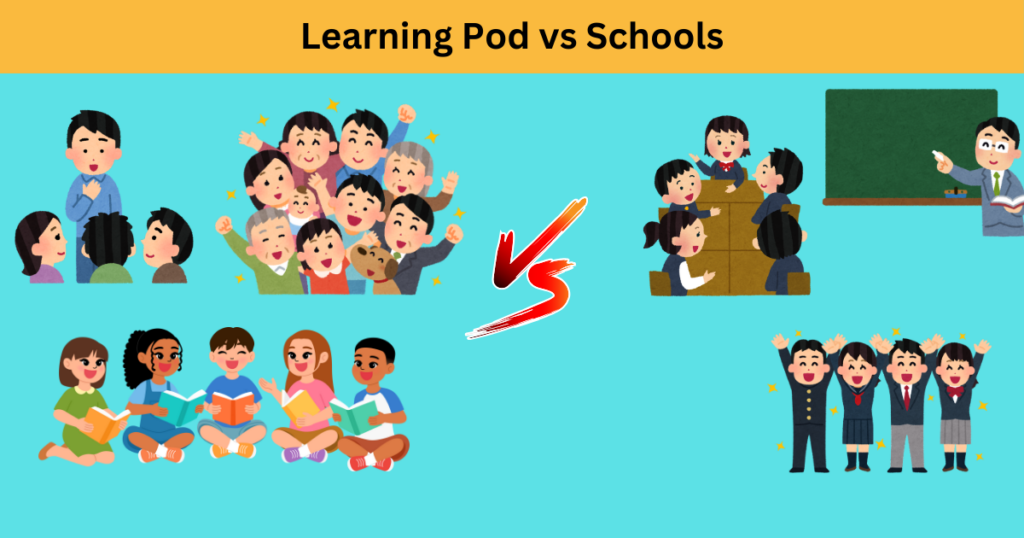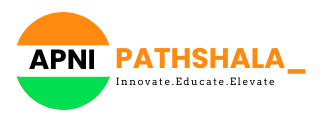Learning Pods vs. Schools

“Live as if you were to die tomorrow. Learn as if you were to live forever.” — Mahatma Gandhi In research done in recent years, one of the major reasons for depression and anxiety in children has been stated to be stress caused by schools due to exams, homework and long hours of hectic classes. With the situation of education changing- Parents, educators and community leaders are constantly looking for better ways to ensure the well-being of their children. One of the many alternatives to schools is Learning pods which have gained attention in recent years after the pandemic. Now- don’t misunderstand my words- Schools have been an important part of every person’s life and have helped in the success of many people for ages. But have you ever asked the question- Why are we still using the ages-old system of schools in modern times? If, yes, then you are at the right place. We want to tell you the differences between schools and learning pods and give you the answer to the question you are looking for – What is better for my child? Keep reading. What Are Learning Pods? A Learning Pod is a community-based learning hub where students can learn, grow and connect in a focused environment. Each pod has its objective whether it’s learning digital skills, creativity, or addressing specific community needs. Many parents go to small, private groups where their children can learn in a more personalized setting. These pods consist of a small group of students, ranging from 3 to 10 children, who meet regularly to learn together. The learning might be taught by a hired tutor, a teacher, or even a parent with teaching experience. The idea is to create a more focused learning environment that meets the needs of each child. How Do Traditional Schools Work? Traditional schools are what most of us have been to in our childhood. They are institutions where children go to learn in a classroom setting with other students of similar age. Schools usually have a curriculum and a fixed schedule. Teachers in these schools are responsible for a larger group of students, often 20 to 30 children, and must follow state or national educational standards. Schools offer a variety of subjects, extracurricular activities, and opportunities. They are the backbone of the education system and have been the primary means of educating children for a long time. Regular Schools follow a schedule—math at 9 AM, science at 10 AM, and lunch at noon. A student who loves sports looks forward to games period and playing, which is something she wouldn’t get in a small learning pod. What are the Differences Between Learning Pods and Traditional Schools? When comparing learning pods to traditional schools, several key differences stand out due to their different methods of working,the scale on which they operate and the number of students they teach. Differences arises between then on the basis of: 1. Size of the Learning Group 2. Flexibility in Curriculum 3. Socialization Opportunities 4. Parental Involvement Advantages of Learning Pods Learning pods have become increasingly popular for several reasons. Here are some of the main advantages: 1. Personalized Learning In a learning pod, the education is designed to the individual needs of each child. The small group size allows for more one-on-one attention, which can lead to better understanding and retention of material. 2. Flexibility Learning pods offer flexibility in both curriculum and schedule. This can be particularly beneficial for children who need a different pace or approach than what traditional schools offer. Sita is passionate about art but finds it hard to dedicate enough time to it at her traditional school. In her learning pod, the curriculum is flexible enough to allow her to spend more time on her art projects. Her tutor brings the lessons in math and history into her art, making learning more interesting. 3. Stronger Relationships The small, close-knit nature of a learning pod can create stronger relationships between the children and the educator. This can create a more supportive and comfortable learning environment. Advantages of Traditional Schooling While learning pods offer many benefits, traditional schools also have their strengths that have been appreciated for generations: 1. Diverse Socialization Traditional schools provide children with the opportunity to interact with a diverse group of peers. This exposure to different children is important in developing social skills. Vivek talks to a lot of students when he goes to school which helps him in making friends and getting to know them better. In contrast to a learning pod where he can talk to a few students only. 2. Access to Resources Schools typically have more resources, including libraries, sports facilities, and extracurricular programs. These resources can improve the overall educational experience. Preeti loves biology and dreams of becoming a doctor. Her traditional school has a fully equipped science lab where she can conduct experiments and a library with a vast collection of biology books. These resources help Preeti pursue her passion, something she might not have access to in a learning pod. 3. Structured Learning The structured environment of a traditional school can be beneficial for many students. The set schedule and curriculum provide a clear path for academic progress. Amaan thrives on routine. He likes knowing that every day at 9 AM, he has math class, followed by science, then lunch, and so on. This predictable schedule in his traditional school helps Amaan stay organized, manage his time effectively, and build a strong work ethic, which might be harder to maintain in a less structured learning pod. 4. Credentialed Teachers Teachers in traditional schools are usually required to have specific qualifications and certifications. This ensures that they are well-trained in both subject matter and teaching methods. Vikram struggles with math, but his traditional school has a math teacher who’s highly experienced in teaching students with different learning abilities. The teacher provides Vikram with extra help after school, using various teaching methods that suit his learning style. This kind
